Back in May of 2015, the Wii U was still a thing. It was an amazing thing. But the Switch has come along and stolen all the glory.
Sure, the Switch is a lot of fun, but the Wii U is a solid low-cost Switch-like experience that’s worthy of exploring. But many are wondering how to store data on it.
In 2015, I lamented the fact that Nintendo missed an opportunity. The black and white versions only shipped with 32 and 8GB of flash storage, respectively. Most gamers would want to download all their games and after a few games, quickly run out of space.
The “missed opportunity” would have been to create an easy 2.5″ SATA slot to insert a HDD or SSD. Instead, Nintendo left us with two USB2 ports.
At the time, my recommendation was to grab a low-power SSD and stick it in an enclosure and plug it into the USB 2 ports. A little complicated, but that was then and this is now.
Maybe you just picked up a Wii U last week. Maybe you’re digging your Wii U out of the closet and want to re-live the fun.
What should you use for storage? Well, I’ll tell you what I’m using:
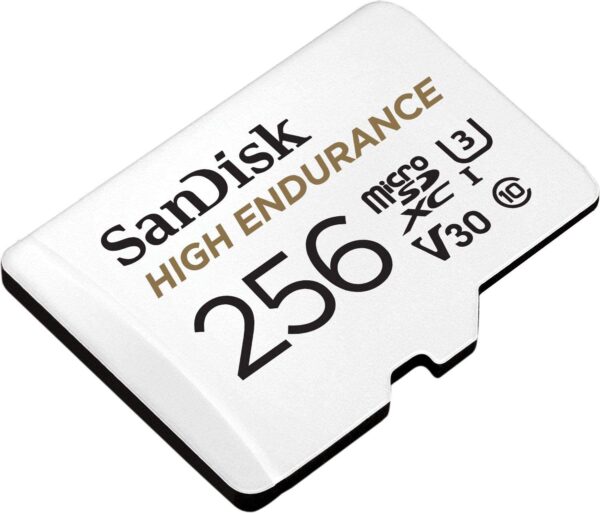
Sandisk MicroSD High Endurance 256GB ($23)
and
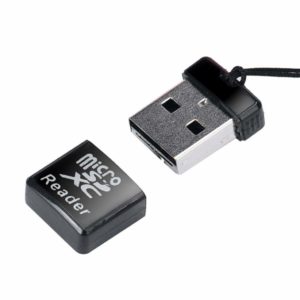
a tiny MicroSD card reader ($6)
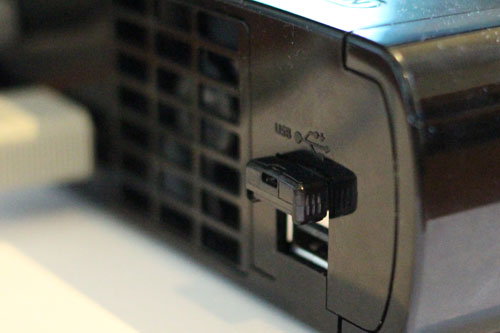
Under $30! Look at how small that is on the back of the Wii U!
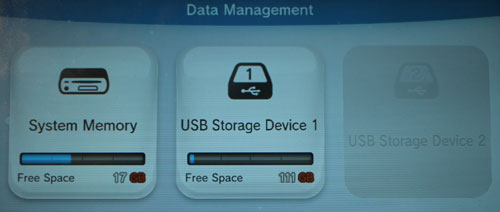
You’ll probably never fill up 256GB of storage. And if you do, well, SanDisk just released a 512GB high endurance version for ~$50.
Why the “High Endurance” version?
SD cards all have dynamic wear-leveling algorithms built into their flash memory controllers. This means that the flash memory controller can help prevent the flash memory from wearing out from too many writes.
While the word “dynamic” sounds great and all, in reality it is really a “passive” form. This means that as you fill up your SD card, there is less space for the memory controller to spread writes around to. If you keep your card less than 50% full, no problem. The wear leveling will do its job.
But if you fill up your card to over 80 or 90% of its capacity, the risk of your card wearing out goes up. The more you fill up your MicroSD card, the greater the risk.
To counter act this risk, it is recommended to use a “High Endurance” SD card. These High Endurance cards use a more durable form of flash memory which can handle a lot more writes than standard SD cards. So you can fill up your SD card with as many games as you can fit without worry of wearing out your SD card.
Moving your games and save data
Have I ever mentioned that you should only use the COPY function (and NEVER the Move function) on the Wii U?

Apparently, if the Wii U fails in its attempt to move your games from one location to another, what happens is that all the games it has already moved are deleted off the source location meanwhile the target location is completely corrupted. Yup, that means you just lost all your save games and you have to re-download your game from the Wii U store. I consider this a bug, but I doubt Nintendo will ever fix it.
Moral of the story: ALWAYS use COPY. Then once you’ve confirmed that everything copied over fine, then (and only then) should you DELETE from the source location.
Want a faster network connection?
You may want to use the 2nd USB port on the back of your Wii U for a 10/100 wired USB 2.0 Ethernet adapter. It’s more reliable than the WiFi connection and you get WAY better network performance.
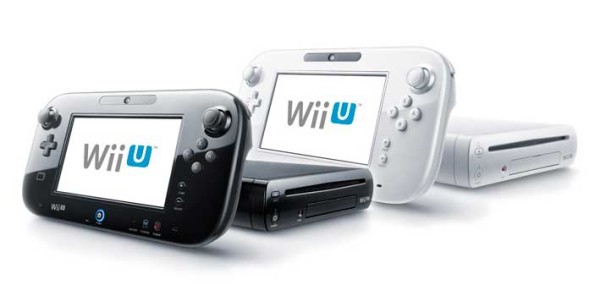
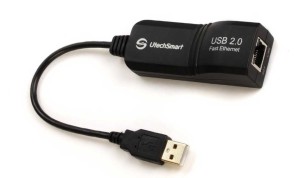



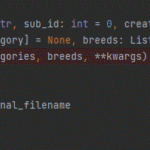
49 replies on “The Best external HDD for the Wii U is a High Endurance 256GB MicroSD card!”
[…] The Best external HDD for the Wii U is a 200GB MicroSD card! […]
Hey was wondering if this still works I’m thinking about doing this
Still works!
Do you think 256gb is enough for a mix of Wii/Wii U games, or go for the 512gb sd card?
Tough question to answer because its usually hard to know how big games are (they vary widely in size) and what games you’re going to get. 256GB is a good start and should cover most folks needs. If you’ve got the spare cash and/or if you just know that you’re going to “get all the games”, then spring for the 512GB.
I can just copy my save games as a backup on the micro SD card and keep the original save files on the Wii U. Would there be any issue with that?
Thanks for the advice – going to try it.
Looking at your recommended device, what are the power requirements of the small reader? You didn’t mention that like your last article did. I’ve tried flash drives before and exceeded the power requirements with them, so I wondered if you checked what that microsd reader uses?
I didn’t measure it mostly because a small MicroSD card reader like this comes in well under the USB2 port’s power limits. I’m surprised that you have flash drives that can exceed a the power requirements of a USB2 port. It would seem those flash drives are “out of spec”.
This is one of the drives I’ve tried. And it wouldn’t do it all of the time, just randomly, usually in the system menu. I don’t remember the error, but it was related to the drive disappearing from the wiiu.
SanDisk Ultra Fit 128GB USB 3.0 Flash Drive (SDCZ43-128G-G46) [Older Version]
Those Sandisk Ultra Fit drives are known to “run hot”. I had one for a while and it was always crazy warm to the touch. I’m convinced that it was generally a poor design. Still, it is surprising that it stops working on USB power.
Forgot my questions on my reply. Have you had that error with the microsd reader, at any point? How long have you been using it that way? Could you check the power requirements to see, since you have the usb power meter?
Never with the MicroSD card reader.
I discovered this “failure mode” early-on when I was trying to use a Samsung slim external HDD. It would work very well for a while, and then randomly during a “MOVE” it would corrupt everything. The Samsung HDD was right at the limits of the USB power limits for the Wii U.
Hello I have heard that the hdd/ssd have a “sleep feature” that needs to be disabled and that is supposedly causing the problem,I myself am in the process of buying a external drive & have heard conflicting things about sd cards/jump drives supposedly wearing out & not being good for use but many ppl have said that that’s not true for new sd cards? I would greatly appreciate it if you can clear that up.
A microSD card has no need to disable a “sleep” feature. I’ve also never experienced an SSD going into sleep mode causing a problem. They’re able to pop out of sleep mode instantaneously. HDDs might take longer to spin up, but I’d personally never use a HDD with the Wii U or the Wii, mostly because I appreciate having extra storage without a separate power cord.
I’m curious if you have any updates on this… is it still as rock solid as you initially found?
No updates. I play my Wii and Wii U sporadically. Both are running off MicroSD cards and they seem to be just fine when I fire them up.
Considering it’s been a while since you were last asked, I’d like to check in and see if anything has changed since then. I’ve heard a lot of conflicting things about different forms of external storage for the Wii U, and I’m a little paranoid to get anything, but if this setup is still working for you more than three years later, I’ll definitely check it out.
Generally, there isn’t much to be worried about. SD Cards will auto detect when they cannot write to their Flash memory and lock the card in a read-only mode. I have 2 cards like this. Data is permanently written to the cards. If this ever happens to you, just buy another microSD card of the same size or larger and copy the old data to the new data.
If you still have any doubts, you can always pick up a SanDisk “High Endurance” or “Max Endurance” brand card. These cards are designed for much higher writing frequency. They’re a little slower and slightly more expensive, but speed isn’t really an issue for the WiiU because the USB ports on the back are only 2.0 and these cards are still faster than that. The only real downside is if you have a LOT of games;
SanDisk’s largest size “High Endurance” cards is 256GB at the moment.2023 update: SanDisk now has a 512GB High Endurance card.Alright, thanks for the detailed description, I feel safer using this method now. I do have another question though. If I were to use a 256GB Max Endurance card, how much game data would need to be on it for there to be a significant amount of slowdown? I’m planning on getting a lot of games, and I would like to have the SD Card be able to write data for the considerable future, but not at the expense of performance.
I just want you to know that I’ve used your solution here since like March or so and it has been ROCK SOLID! Thank you SO MUCH for this suggestion, as before I was having corruptions with flash drives within a few days of installing my games. It’s been 8 months of solid performance with your solution!
I plan on upgrading to 400GB because I’m at the limit for the 200GB!
I do have on question: I’m confused on a certain aspect of “move” vs “copy”. I THINK I remember the Wii U saying something to the effect of “copying only copies over the game and not your saves/etc., but moving sends everything over”, am I just trippin? Lol. Because I am definitely cautious of moving since it caused some corruptions early on. Will copying copy everything over?
Also, you think moving from my 200GB to my 400GB (using two of the devices you recommended here) will exceed any USB Wii U power limits?
Thanks for this AWESOME solution! More Wii U owners ought to know about it. It’s clean and small and elegant! 🙂
Yes, to the best of my knowledge, the COPY function moves your SAVES as well as the game files over. Though, there’s one way to test this:
– Perform a COPY of a game from a Source to a Target
– Power down the WiiU system
– Remove the Source from the WiiU
– Power up the WiiU system and see if the game and the save data is still there on the Source
(I’m pretty sure it is, but be sure to test it out.)
Regarding power usage, MicroSD cards are all low power and should not exceed the power limits of the USB2 bus on the WiiU
Just reporting back in!
You were right about “Copy” vs “Move”. I found out what confused me before: it says that Wii saves won’t copy over, which makes sense because those saves are stored on vWii Nand, not usb storage. So yeah, I was just failing reading comprehension lol.
On the transfer itself, I’m SO GLAD I did “copy” instead of “move” because:
I bought a mini SD adapter that was as close as possible to my original, but it failed the first 3 times while copying TO it (as in, it would finish, but then trying to load up a large game would eventually result in an error message and hard reset)!!! That would have ruined my storage if I did “Move” so, THANK YOU!
I eventually figured “huh, lets try it the opposite way and copy TO my OLD adapter”, and I noticed that the copy was taking 12 times longer (2+ days)!!! So clearly something was different. And lo and behold, after all that, the new storage worked PERFECTLY (but not before I ordered like 5 other adapters to be safe, haha, but they are cheap so no problem!). So it seems that *something* within the writing process of the new adapter is broken, but reading was fine! In either case, I’m keeping the new storage in the OLD adapter, since I know for sure that one works (and keeping the old mini SD juuuust in case).
And, after having installed 22 new games, I still have 200GB EXTRA storage left to add a ton of GameCube, Wii, and Wii U games. The Wii U is truly an untapped BEAST and I’m pumped!
Thank you again for this guide! I hope this little comment of mine helps someone in my unique situation. Everyone should know about your sleek method here!
As someone who finally got a Wii U and wants more storage for all the games I want to get, I just need to ask a couple questions.
1. Is the Wii U able to run and save games from the SD card, and can purchases on the eShop be saved right to it?
2. Is this a completely fail-safe method? I just want to be extra sure I don’t mess anything up trying this.
Yes, if you use the MicroSD card and the USB adapter, you can download games right from the eShop as well as run and save games to this card. No need for a bulky external drive. And I would say that with the tiny USB adapter and a High Endurance microSD card, this is about a fail-safe as you can get. No worries of an external power supply failing or the drive accidentally getting yanked out.
Thanks for the response! And I assume any games already saved to the console can be copied over to the USB too? I have several large games and demos on my Wii U and would like to free up space.
Yes, indeed. It’s easy to copy your existing games and data from “System Memory” over to your new “USB Storage Device”.
How is the loading speed compared to USB HDD? I currently use an HDD but the cable is pretty annoying.
Loading speeds are slightly faster with the microSD card (much lower seek latency), but overall, they’re pretty similar because both the microSD card and the USB HDD are limited by the USB 2.0 bus (~35MB/sec throughput rate).
Hey I know this is a bit old but you replied to other people in 2022 so I hope you can answer. I decided to go with this method for storage and I just got the sd card in the mail. It’s the same sandisk high endurance 256gb. I have this adapter:
https://www.amazon.ca/gp/product/B006T9B6R2/ref=ppx_yo_dt_b_asin_title_o03_s00?ie=UTF8&psc=1
I was expecting it to ask me to format in the wii u but it doesn’t. The blue light on the adapter is on, and I can see the sd card when it’s in my pc using the adapter. I don’t know why I can’t format it but I’m kinda disappointed cause I was excited to get it all setup. Thanks for any help.
OK it worked when I used the adapter that came with the micro sd in the usb. The usb has a micro sd slot and sd slot and the micro slot wasn’t working. Hopefully doing micro sd -> sd adapter -> usb is okay
Hey Skyler, yes, my suspicion was that the USB adapter (that you linked to) had 2 card slots and the microSD card slot was appearing as drive #2 (which the WiiU probably doesn’t recognize). By putting the microSD card in the SD card adapter and putting it in the SD card slot, it probably shows up as drive #1 to the WiiU (which it *does* recognize). And yes, using the SD card adapter is just fine. It’s just a straight electrical pass-thru; nothing fancy or complicated.
Hi, Thank you for good tips. I have used it to build my setup with 2 microSD Samsung Endurance cards. Everything was working good, but I think I have a problem with from SD slot contacts. I am taking the front SD card in and out quite often these days, and I noticed that from time to time im getting payload load failed errors. Then, today Nintendont started to randomly crash. Have you ever experienced something like this?
I will try to clean the slot (by putting isopropyl on the SD adapter) and try another adapter tomorrow.
Thanks! m
Yo! Thanks again for this, but I just noticed, how come you only have 111GB of free space if you used a 256GB card? I got a 128GB and it had about the same free space, so maybe you used a 128GB for the picture, or you really filled up over half of it already? (Or maybe the WiiU cannot make proper bar graphs to show capacity vs used! 🤭)
Good eye. The screenshot is from a 120 GB SSD, I think. (111GB after formatting.)
Would it effect it if I didn’t use a high endurance card? (sorry if English isn’t good. It’s not my first Lanaguage)
If you do not use a High Endurance card, be certain to NOT fill up the card. (Leave the card at least 50% empty.) You want to leave enough “empty” sectors for the microsd card to spread “writes” around the card evenly.
I saw this article a while back and decided to buy the micro SD card and the adapters you recommended. Everything seems to be working perfectly fine so far.
This has me wondering. Why was Nintendo so worried about the integrity of the storage and recommending HDDs for WiiU? Is there really a substantial chance of data/game loss if you were to use a micro sd card that isn’t high endurance?
The Switch and Steamdeck both use standard micro sd cards and I haven’t seen any warnings about data loss, card wear, or recommendations for high endurance cards.
Is there something about the way the WiiU writes/reads data that would cause more wear on the card? Or maybe there’s something about the nature of running an SD card from a USB port through an adapter that isn’t as stable?
I’ve just been curious if you or anyone has come across any information on why they’d recommend against non HDD storage for one device yet recommend it for another device.
Anyways. Thanks for posting this info Pretzel 🙂
I was finally able to simplify my setup, move my bulky external HD out of my entertainment stand, save an outlet on my power strip, and use the drive somewhere else.
Hey Chad,
This is a great question and one that I’ve wondered about myself. Though I think I may know the answer.
The WiiU was launched in late 2012. At that point, USB and MicroSD cards were still pretty small, so most people wouldn’t be using them (compared to HDDs which could easily hold Terabytes!)
The assumption from Nintendo would have been that everyone would be using an external Hard drive. As you probably know, HDDs can handle LOTS of repeated little writes here and there without any difficulty. The internal WiiU OS and game developers probably assumed that NAND flash memory limitations wouldn’t be a thing they would have to worry about.
The recommendation of using high-endurance microSD card is a hedge against the possibility of premature wear due to a naive filesystem being unaware of Flash NAND limitations.
Modern mobile game decks like the Steam Deck and the Nintendo Switch were built with microSD card slots (not USB2 ports) and so the engineering task of dealing with Flash NAND limitations are fully considered from the beginning.
I imagine that the OSes (of both Steam Deck and the Switch) take into consideration the consolidation of “writes” so as to reduce wear. Perhaps the systems even do some form of their own “static” (aka. active) wear-leveling to prolong the life of any microSD card put in the deck.
Just found this article now.
I’m currently using a sturdy USB stick to store ~42GBs of games for my Wii U (the USB stick is just over halfway full though), with a remaining ~8GBs of games on the Wii U itself. I don’t use it all that often, and many games don’t even have save files yet, so I’m not worried about the USB stick giving out any time soon. But, I do think it would be smart to consider this High Performance MicroSD card + MicroSD card reader option.
Because I currently have the USB stick plugged in, what are the steps I should take to COPY (not move haha) all the games and save data from the Wii U and the USB stick to the MicroSD card?
Also, how does the card reader actually work? If it’s plugged into the back, and the MicroSD card is in the front, how does it know? When do I plug it in? Will the Wii U recognize it with a USB already plugged in?
It’s probably pretty straightforward, but I don’t want to do it wrong.
Thanks to anyone who can provide advice!
Hi Matt. The MicroSD card gets inserted into the tiny microSD card USB reader and then you plug it all in the USB port in the back.
Also, it’s a High Endurance card (meaning that it can handle a lot more WRITEs before wearing out than your average MicroSD card.)
The MicroSD card and USB reader just arrived in the mail.
Yes, I see how it fits. When trying it now, it says “the Wii U storage device could not be recognized” and mentions I need to have it formatted. I looked up how to do so for these larger MicroSD cards, and once that’s done, I’ll try again. Thanks for your quick reply!
Well, I downloaded Rufus to properly format the MicroSD card to FAT32, and made all the selections that people recommended. The Wii U provided the same message – “one or more storage devices need to be formatted before transferring data” – so I’m trying the official SD formatting program that Nintendo links to on their website. Did anyone else experience this much hassle?
Hey, none of this worked for me. I tried formatting it multiple times, following the instructions and using multiple formatting programs… Nothing. What gives?
Hey Matt. Hopefully you’ve figured something out by now, but when I did it, I just used the WiiU to format mine, both a 128GB and a 256GB one. I ended up getting a bigger one for more writes while keeping the smaller as a monthly/quarterly backup. I highly recommend using 2 different sizes for this because you never know which one the WiiU will name USB 1 vs USB 2 each time
Not sure if the response went through but I just want to know if there would be any issues/problems if I keep the original save files on my Wii U and save the copies on the Micro SD card as a backup?
Yeah, that should be fine.
(Sorry about the slow approval of your comment. I get so many spam bots trying to spam my website…)
Thank you for your response! 1 last question, for example if I need to update my save files on the backup SD micro, do I just delete it and then copy it from my Wii U. I just want to make sure that I don’t get any errors or it does not delete everything.
That’s a good question. I suppose try copying over the existing save file. I would only delete first if it doesn’t permit overwriting.